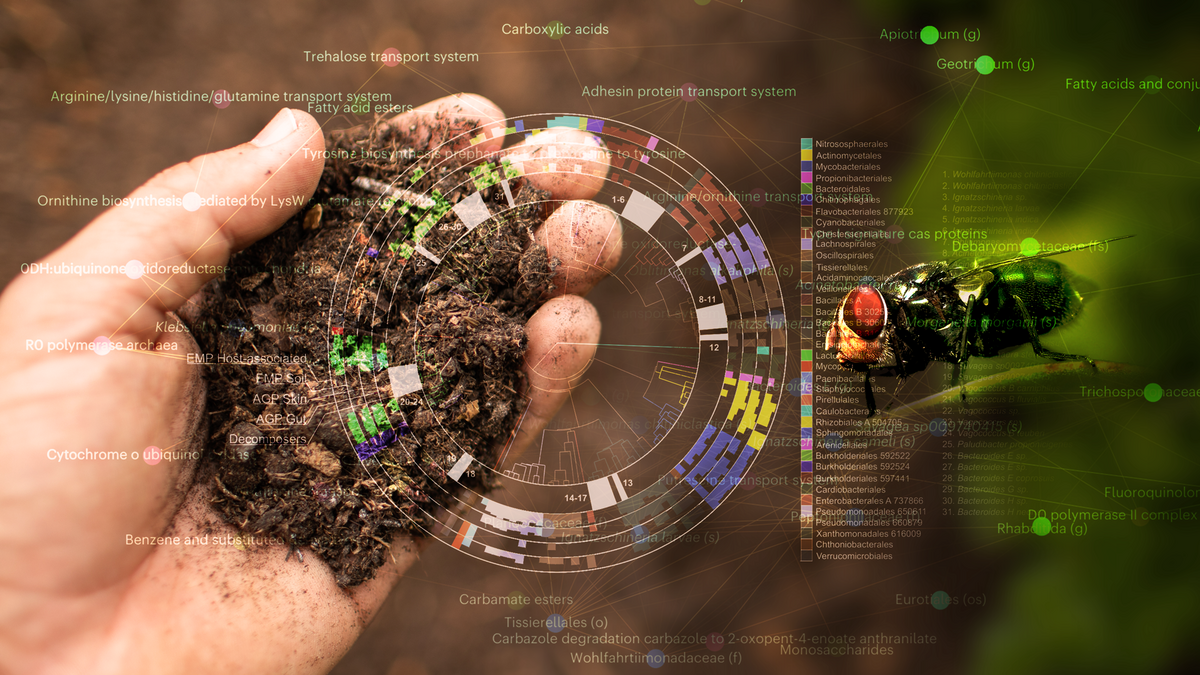Advances in forensic science improve accuracy of time-of-death estimates

An insect-borne suite of microbes helps decompose flesh after death according to a rigid timetable. Graphic by Jason Drees/ASU
Accurate time-of-death estimates are a mainstay of murder mysteries and forensic programs, but such calculations in the real world are often complex and imprecise.
In a first-of-its-kind study, Arizona State University researchers and their colleagues have discovered a group of common microbes that work together specifically to decompose flesh. These microorganisms serve as a biological clock and allow scientists to investigate the post-mortem breakdown of tissue with unprecedented precision.
Researchers explored a network of some 20 microbes responsible for cadaver decomposition across different climates and seasons. The findings demonstrate that a microbial orchestration of decay operates according to a strict timetable. This predictable behavior allows for accurate time-of-death estimates, regardless of environmental conditions.
The study also shows that these “universal decomposers” are largely unique to decomposition environments and are not commonly found in other soil or host-associated microbial communities.
“High-throughput technologies like DNA sequencing and mass spectrometry generate large volumes of data,” said Qiyun Zhu, part of the team of researchers. “Such approaches often yield deeper insights into fundamental questions than traditional methods do.”
Zhu is a researcher with the Biodesign Center for Fundamental and Applied Microbiomics at ASU and an assistant professor with the School of Life Sciences.
The research appears in the current issue of the journal Nature Microbiology.
The three research sites used for the study, located within two divergent climate zones — temperate forest and semi-arid steppe — showed a consistent pattern of results. The same set of 20 decomposing microbes, including rare bacteria and fungi, were found across all cadavers. This group of microbes demonstrated consistent consumption behavior that appeared to be unaffected by variations in environmental conditions.
The researchers also applied machine learning to the field data to develop a predictive model for time of death, based on microbial activity. Shedding new light on the microbial ecology of decomposition, the research represents a significant advance for forensic science, and it could also impact agricultural and food industries by enhancing the understanding of nutrient recycling and soil health.
Unearthing vertebrate decay
The decomposition of dead biological material is one of nature’s most fundamental phenomena. Most decaying matter consists of organic plant waste, and such processes are relatively well understood. Much less is known about the ecology of vertebrate decomposition, including that of humans, and a better understanding of this progression is of primary concern to forensic scientists.
This multiyear study involved the decomposition of 36 cadavers at three different forensic anthropological facilities — the University of Tennessee, Knoxville; Sam Houston State University; and Colorado Mesa University. The bodies, collected from three willed-body donation facilities, were decomposed in different climates and during all four seasons.
During the first 21 days for each decomposing body, researchers collected skin and soil samples from the cadavers and graves undergoing decomposition. The research team also took samples from unaffected soil for comparison and recorded daily environmental conditions, including temperature, humidity and other atmospheric data.
The team then constructed an overall picture of the microbial community, or microbiome, present at each site. This demonstrated which microbes were present, where they came from and how their activities changed over time.
Timely arrival
Surprisingly, researchers found the same set of approximately 20 microbes that specialize in decomposition on all 36 bodies, regardless of climate or soil type. Further, these microbes arrived punctually at specific time points throughout the 21-day observation period. This living network is not just a random assembly of microorganisms but a structured community that plays a critical role in breaking down the body.
Notably, this specialized suite of microbes was not found in soil microbiome databases or human skin and gut microbiome catalogs. Instead, insects — particularly carrion beetles and blowflies — act as microbe carriers. Their interaction with cadavers facilitates the spread of these microorganisms, thereby accelerating the decomposition process.
Data derived from universal decomposing microbes offer several advantages during forensic analysis of death scenes. In addition to their consistent behavior over a broad range of seasonal conditions, these primary decomposing microbes are guaranteed to appear at every scene, unlike fingerprints, bloodstains, photographs or other forms of conventional evidence. The arrival of a particular microbe during decomposition depends on the state of the cadaver.
The team used machine learning to develop a predictive model based on the microbial ecology found on decomposing bodies. This model demonstrated high accuracy and was validated using an independent set of samples from various climates, confirming its reliability in predicting time of death within three calendar days. Future efforts aim to refine models and improve the accuracy of predictions.
More Science and technology

Turning up the light: Plants, semiconductors and fuel production
What can plants and semiconductors teach us about fuel production?ASU's Gary Moore hopes to find out.With the aim of learning how to create viable alternatives to fossil-based fuels, Moore — an…

ASU technical innovation enables more reliable and less expensive electricity
Growing demand for electricity is pushing the energy sector to innovate faster and deploy more resources to keep the lights on and costs low. Clean energy is being pursued with greater fervor,…

What do a spacecraft, a skeleton and an asteroid have in common? This ASU professor
NASA’s Lucy spacecraft will probe an asteroid as it flys by it on Sunday — one with a connection to the mission name.The asteroid is named Donaldjohanson, after Donald Johanson, who founded Arizona…


